Measuring and Quantifying Impacts of Environmental Parameters on Airborne Particulate Matter in Under-Viaducts Spaces in Wuhan, China
Abstract
1. Introduction
2. Methodology
2.1. Study Area and Measurement Sites
2.2. Data Collection
2.2.1. Sampling Site Selection
2.2.2. Measuring Particulate Matter Concentration
2.2.3. Measuring and Calculating Greening and Environmental Parameters in UVSs
2.3. Data Analysis
3. Results
3.1. Characteristics of Particulate Matter Concentrations in UVSs
3.2. Effects of Environmental Parameters on Airborne Particulate Matter
3.2.1. Effects of Environmental Parameters on a Single Type of Particulate Matter
3.2.2. Correlation Degree of Different Environmental Parameters on Particulate Matter
3.3. Multiple Regression Predictive Models of Environmental Parameters and Net Concentration Differences of Particulate Matter
3.3.1. Summer Prediction Model
3.3.2. Winter Prediction Model
4. Discussion
4.1. Differences in Particulate Matter Concentration in Urban UVSs
4.2. Effects of Environmental Parameters on Particulate Matter Concentration
4.3. Practical Significance
5. Conclusions
Author Contributions
Funding
Institutional Review Board Statement
Informed Consent Statement
Data Availability Statement
Acknowledgments
Conflicts of Interest
References
- Carbonell, L.; Ruiz, E.M.; Carrera, D.W.; Zucchetti, M. Global and local atmospheric pollution evaluation and control. challenges for a small island and for developing countries. Fresenius Environ. Bull. 2010, 19, 2354–2360. [Google Scholar]
- Grimm, N.B.; Faeth, S.H.; Golubiewski, N.E.; Redman, C.L.; Wu, J.; Bai, X.; Briggs, J.M. Global Change and the Ecology of Cities. Science 2008, 319, 756–760. [Google Scholar] [CrossRef] [PubMed]
- Zhang, Q.; He, K.; Huo, H. Cleaning China’s air. Nat. Cell Biol. 2012, 484, 161–162. [Google Scholar] [CrossRef] [PubMed]
- Prendes, P. Source apportionment of inorganic ions in airborne urban particles from Coruña city (N.W. of Spain) using positive matrix factorization. Talanta 1999, 49, 165–178. [Google Scholar] [CrossRef]
- Rohde, R.A.; Muller, R.A. Air Pollution in China: Mapping of Concentrations and Sources. PLoS ONE 2015, 10, e0135749. [Google Scholar] [CrossRef]
- Giani, P.; Anav, A.; De Marco, A.; Feng, Z.; Crippa, P. Exploring sources of uncertainty in premature mortality estimates from fine particulate matter: The case of China. Environ. Res. Lett. 2020, 15, 064027. [Google Scholar] [CrossRef]
- Liu, J.; Zhai, J.; Zhu, L.; Yang, Y.; Liu, J.; Zhang, Z. Particle removal by vegetation: Comparison in a forest and a wetland. Environ. Sci. Pollut. Res. 2017, 24, 1597–1607. [Google Scholar] [CrossRef]
- Silver, B.; Reddington, C.; Arnold, S.; Spracklen, D.V. Substantial changes in air pollution across China during 2015–2017. Environ. Res. Lett. 2018, 13, 114012. [Google Scholar] [CrossRef]
- Ding, D.; Xing, J.; Wang, S.; Liu, K.; Hao, J. Estimated Contributions of Emissions Controls, Meteorological Factors, Population Growth, and Changes in Baseline Mortality to Reductions in Ambient PM2.5 and PM2.5-Related Mortality in China, 2013–2017. Environ. Heal. Perspect. 2019, 127, 067009. [Google Scholar] [CrossRef]
- Pant, P.; Harrison, R.M. Estimation of the contribution of road traffic emissions to particulate matter concentrations from field measurements: A review. Atmos. Environ. 2013, 77, 78–97. [Google Scholar] [CrossRef]
- HEI. Panel on the Health Effects of Traffic-Related Air Pollution. Traffic-Related Air Pollution: A Critical Review of the Literature on Emissions, Exposure, and Health Effects; Health Effects Institute Boston: Boston, MA, USA, 2010. [Google Scholar]
- Zhi, H.; Qiu, Z.; Wang, W.; Wang, G.; Hao, Y.; Liu, Y. The influence of a viaduct on PM dispersion in a typical street: Field experiment and numerical simulations. Atmos. Pollut. Res. 2020, 11, 815–824. [Google Scholar] [CrossRef]
- Yin, L. Research on Natural Light and Greening Landscape under Urban Viaducts; Huazhong University of Science & Technology Press: Wuhan, China, 2016. [Google Scholar]
- Dai, X.R.; Rao, C.K.; Xiao, W.X. Study on the space utilization under the urban viaducts: A case study on Hangzhou main city. J. Zhejiang Univ. (Sci. Ed.) 2009, 36, 723–730. [Google Scholar]
- Haydn, F.; Temel, R. Temporary Urban Spaces: Concepts for the Use of City Spaces; Birkhäuser: Berlin, Germany, 2006. [Google Scholar]
- Xia, H.; Gao, Z.; Wang, B. Study on the Space Utilization under the Urban Viaducts of Harbin Main City Zone. In Applied Mechanics and Materials; Zhang, X.D., Li, H.N., Eds.; Trans Tech Publications: Stafa-Zurich, Switzerland, 2013; pp. 110–113. [Google Scholar] [CrossRef]
- Zwack, L.M.; Paciorek, C.J.; Spengler, J.D.; Levy, J.I. Characterizing local traffic contributions to particulate air pollution in street canyons using mobile monitoring techniques. Atmos. Environ. 2011, 45, 2507–2514. [Google Scholar] [CrossRef]
- Łowicki, D. Landscape pattern as an indicator of urban air pollution of particulate matter in Poland. Ecol. Indic. 2019, 97, 17–24. [Google Scholar] [CrossRef]
- Chen, M.; Dai, F.; Yang, B.; Zhu, S. Effects of urban green space morphological pattern on variation of PM2.5 concentration in the neighborhoods of five Chinese megacities. Build. Environ. 2019, 158, 1–15. [Google Scholar] [CrossRef]
- Qiu, L.; Liu, F.; Zhang, X.; Gao, T. The Reducing Effect of Green Spaces with Different Vegetation Structure on Atmospheric Particulate Matter Concentration in BaoJi City, China. Atmosphere 2018, 9, 332. [Google Scholar] [CrossRef]
- Cai, L.; Zhuang, M.; Ren, Y. A landscape scale study in Southeast China investigating the effects of varied green space types on atmospheric PM2.5 in mid-winter. Urban For. Urban Green. 2020, 49, 126607. [Google Scholar] [CrossRef]
- Guo, L.; Luo, J.; Yuan, M.; Huang, Y.; Shen, H.; Li, T. The influence of urban planning factors on PM2.5 pollution exposure and implications: A case study in China based on remote sensing, LBS, and GIS data. Sci. Total. Environ. 2019, 659, 1585–1596. [Google Scholar] [CrossRef]
- Feng, H.; Zhao, J.; Li, Z. Experimental study on the diffusion of respirable particulate matter in street valley under elevated roads. In Proceedings of the 2015 2nd International Conference on Machinery, Materials Engineering, Chemical Engineering and Biotechnology; Atlantis Press: Paris, France, 2016. [Google Scholar]
- Lu, M.; Tang, X.; Wang, Z.; Liang, S.; Hao, J.; Zhou, H.; Li, F.; Hu, K.; Hu, S.; Li, P.; et al. Investigating the spatial-temporal distribution of the PM2.5 over Wuhan in 2014 and quantifying the contributions from different source regions with both observation and model. Acta Sci. Circumstantiae 2017, 11, 4227–4240. [Google Scholar] [CrossRef]
- Fan, S.; Li, X.; Han, J.; Cao, Y.; Dong, L. Field assessment of the impacts of landscape structure on different-sized airborne particles in residential areas of Beijing, China. Atmos. Environ. 2017, 166, 192–203. [Google Scholar] [CrossRef]
- Lim, M.C.; Ayoko, G.A.; Morawska, L.; Ristovski, Z.D.; Jayaratne, E.R.; Kokot, S. A comparative study of the elemental composition of the exhaust emissions of cars powered by liquefied petroleum gas and unleaded petrol. Atmos. Environ. 2006, 40, 3111–3122. [Google Scholar] [CrossRef]
- Kaur, S.; Nieuwenhuijsen, M.; Colvile, R. Pedestrian exposure to air pollution along a major road in Central London, UK. Atmos. Environ. 2005, 39, 7307–7320. [Google Scholar] [CrossRef]
- El-Hifnawi, D.; Neudert, M.; Hardt, A.; Hauswald, B.; Zahnert, T. Anaphylaktische Reaktion nach Sojagenuss bei einem Patienten mit Birkenpollenallergie. HNO 2011, 60, 117–119. [Google Scholar] [CrossRef]
- Field, M.S. Karst Hydrology and Chemical Contamination. J. Environ. Syst. 1992, 22, 1–26. [Google Scholar] [CrossRef]
- Monn, C.; Braendli, O.; Schaeppi, G.; Schindler, C.; Ackermann-Liebrich, U.; Leuenberger, P. Particulate matter <10 μm (PM10) and total suspended particulates (TSP) in urban, rural and alpine air in Switzerland. Atmos. Environ. 1995, 29, 2565–2573. [Google Scholar] [CrossRef]
- Lim, S.; Lee, M.; Lee, G.; Kim, S.; Yoon, S.; Kang, K. Ionic and carbonaceous compositions of PM10, PM2.5 and PM1.0 at Gosan ABC Superstation and their ratios as source signature. Atmos. Chem. Phys. Discuss. 2012, 12, 2007–2024. [Google Scholar] [CrossRef]
- Yang, L.; Wu, Y.; Li, J.; Song, S.; Zheng, X.; Hao, J. Mass concentrations and temporal profiles of PM10, PM2.5 and PM1 near major urban roads in Beijing. Front. Environ. Sci. Eng. 2014, 9, 675–684. [Google Scholar] [CrossRef]
- Boarnet, M.G.; Houston, D.; Edwards, R.; Princevac, M.; Ferguson, G.; Pan, H.; Bartolome, C. Fine particulate concentrations on sidewalks in five Southern California cities. Atmos. Environ. 2011, 45, 4025–4033. [Google Scholar] [CrossRef]
- Fontes, T.; Li, P.; Barros, N.; Zhao, P. Trends of PM 2.5 concentrations in China: A long term approach. J. Environ. Manag. 2017, 196, 719–732. [Google Scholar] [CrossRef]
- Heydari, S.; Tainio, M.; Woodcock, J.; de Nazelle, A. Estimating traffic contribution to particulate matter concentration in urban areas using a multilevel Bayesian meta-regression approach. Environ. Int. 2020, 141, 105800. [Google Scholar] [CrossRef]
- Conte, M.; Contini, D. Size-resolved particle emission factors of vehicular traffic derived from urban eddy covariance measurements. Environ. Pollut. 2019, 251, 830–838. [Google Scholar] [CrossRef] [PubMed]
- Jeanjean, A.; Monks, P.; Leigh, R. Modelling the effectiveness of urban trees and grass on PM2.5 reduction via dispersion and deposition at a city scale. Atmos. Environ. 2016, 147, 1–10. [Google Scholar] [CrossRef]
- Freiman, M.T.; Hirshel, N.; Broday, D.M. Urban-scale variability of ambient particulate matter attributes. Atmos. Environ. 2006, 40, 5670–5684. [Google Scholar] [CrossRef]
- Cyrys, J.; Pitz, M.; Heinrich, J.; Wichmann, H.-E.; Peters, A. Spatial and temporal variation of particle number concentration in Augsburg, Germany. Sci. Total. Environ. 2008, 401, 168–175. [Google Scholar] [CrossRef] [PubMed]
- Bealey, W.; McDonald, A.; Nemitz, E.; Donovan, R.; Dragosits, U.; Duffy, T.; Fowler, D. Estimating the reduction of urban PM10 concentrations by trees within an environmental information system for planners. J. Environ. Manag. 2007, 85, 44–58. [Google Scholar] [CrossRef] [PubMed]
- Janhäll, S. Review on urban vegetation and particle air pollution–Deposition and dispersion. Atmos. Environ. 2015, 105, 130–137. [Google Scholar] [CrossRef]
- Liu, X.-H.; Yu, X.-X.; Zhang, Z.-M.; Liu, M.-M.; Ruanshi, Q.-C. Pollution characteristics of atmospheric particulates in forest belts and their relationship with meteorological conditions. Chin. J. Ecol. 2014, 33, 1715–1721. [Google Scholar] [CrossRef]
- Jie, L.; KePeng, H.; Xiaodong, W.; Peng, Y. Temporal-Spatial Variations of Concentrations of PM10 and PM2.5 in Ambient Air. Pol. J. Environ. Stud. 2016, 25, 2435–2444. [Google Scholar] [CrossRef][Green Version]
- Biglari, H.; Geravandi, S.; Mohammadi, M.J.; Porazmey, E.J.; Chuturkova, R.Z.; Khaniabadi, Y.O.; Goudarzi, G.; Mohammadi, B.; Yari, A.R. Relationship between air particulate matter and meteorological parameters. Fresenius Environ. Bull. 2017, 26, 4047–4056. [Google Scholar]
- Huang, F.; Zhou, J.; Li, H.; Chen, N. Analysis of causes and sources of typical air pollution events in summer and winter in Wuhan city. Res. Environ. Sci. 2020, 33, 280–288. [Google Scholar] [CrossRef]
- Yan, J.; Liu, H.; Ge, Q.; Zheng, J.; Hao, Z.; Wang, Y. Reconstruction and analysis of annual mean temperature of Wuhan for the 1906–2015 period. Prog. Geogr. 2017, 36, 1176–1183. [Google Scholar] [CrossRef]
- Nowak, D.J.; Crane, D.E.; Stevens, J.C. Air pollution removal by urban trees and shrubs in the United States. Urban For. Urban Green. 2006, 4, 115–123. [Google Scholar] [CrossRef]
- Dawson, J.P.; Adams, P.J.; Pandis, S.N. Sensitivity of PM2.5 to climate in the Eastern US: A modeling case study. Atmos. Chem. Phys. Discuss. 2007, 7, 4295–4309. [Google Scholar] [CrossRef]
- Qiu, L.; Liu, F.; Zhang, X.; Gao, T. Reducing Effect of Air Particulate Matter Concentration by Green Spaces with Different Vegetation Structure in City Parks. Res. Environ. Sci. 2018, 31, 1685–1694. [Google Scholar] [CrossRef]
- Deng, S.; Ma, J.; Zhang, L.; Jia, Z.; Ma, L. Microclimate simulation and model optimization of the effect of roadway green space on atmospheric particulate matter. Environ. Pollut. 2019, 246, 932–944. [Google Scholar] [CrossRef]
- Gromke, C.; Buccolieri, R.; Di Sabatino, S.; Ruck, B. Dispersion study in a street canyon with tree planting by means of wind tunnel and numerical investigations–Evaluation of CFD data with experimental data. Atmos. Environ. 2008, 42, 8640–8650. [Google Scholar] [CrossRef]
- Kumar, P.; Garmory, A.; Ketzel, M.; Berkowicz, R.; Britter, R. Comparative study of measured and modelled number concentrations of nanoparticles in an urban street canyon. Atmos. Environ. 2009, 43, 949–958. [Google Scholar] [CrossRef][Green Version]
- Buccolieri, R.; Salizzoni, P.; Soulhac, L.; Garbero, V.; Di Sabatino, S. The breathability of compact cities. Urban Clim. 2015, 13, 73–93. [Google Scholar] [CrossRef]
- Jeanjean, A.P.; Buccolieri, R.; Eddy, J.; Monks, P.S.; Leigh, R.J. Air quality affected by trees in real street canyons: The case of Marylebone neighbourhood in central London. Urban For. Urban Green. 2017, 22, 41–53. [Google Scholar] [CrossRef]
- Nowak, D.J.; Hirabayashi, S.; Doyle, M.; McGovern, M.; Pasher, J. Air pollution removal by urban forests in Canada and its effect on air quality and human health. Urban For. Urban Green. 2018, 29, 40–48. [Google Scholar] [CrossRef]
- Gu, H.; Cao, Y.; Elahi, E.; Jha, S.K. Human health damages related to air pollution in China. Environ. Sci. Pollut. Res. 2019, 26, 13115–13125. [Google Scholar] [CrossRef]
- Wang, H.; He, X.; Liang, X.; Choma, E.F.; Liu, Y.; Shan, L.; Zheng, H.; Zhang, S.; Nielsen, C.P.; Wang, S.; et al. Health benefits of on-road transportation pollution control programs in China. Proc. Natl. Acad. Sci. USA 2020, 117, 25370–25377. [Google Scholar] [CrossRef]
- Abhijith, K.; Kumar, P.; Gallagher, J.; McNabola, A.; Baldauf, R.; Pilla, F.; Broderick, B.; Di Sabatino, S.; Pulvirenti, B. Air pollution abatement performances of green infrastructure in open road and built-up street canyon environments–A review. Atmos. Environ. 2017, 162, 71–86. [Google Scholar] [CrossRef]
- Sahanavin, N.; Prueksasit, T.; Tantrakarnapa, K. Relationship between PM 10 and PM 2.5 levels in high-traffic area determined using path analysis and linear regression. J. Environ. Sci. 2018, 69, 105–114. [Google Scholar] [CrossRef]
- Abhijith, K.; Kumar, P. Field investigations for evaluating green infrastructure effects on air quality in open-road conditions. Atmos. Environ. 2019, 201, 132–147. [Google Scholar] [CrossRef]
- Hang, J.; Li, Y.; Sandberg, M.; Buccolieri, R.; Di Sabatino, S. The influence of building height variability on pollutant dispersion and pedestrian ventilation in idealized high-rise urban areas. Build. Environ. 2012, 56, 346–360. [Google Scholar] [CrossRef]
- Li, X.-B.; Lu, Q.-C.; Lu, S.-J.; He, H.-D.; Peng, Z.-R.; Gao, Y.; Wang, Z.-Y. The impacts of roadside vegetation barriers on the dispersion of gaseous traffic pollution in urban street canyons. Urban For. Urban Green. 2016, 17, 80–91. [Google Scholar] [CrossRef]
- Gromke, C.; Jamarkattel, N.; Ruck, B. Influence of roadside hedgerows on air quality in urban street canyons. Atmos. Environ. 2016, 139, 75–86. [Google Scholar] [CrossRef]
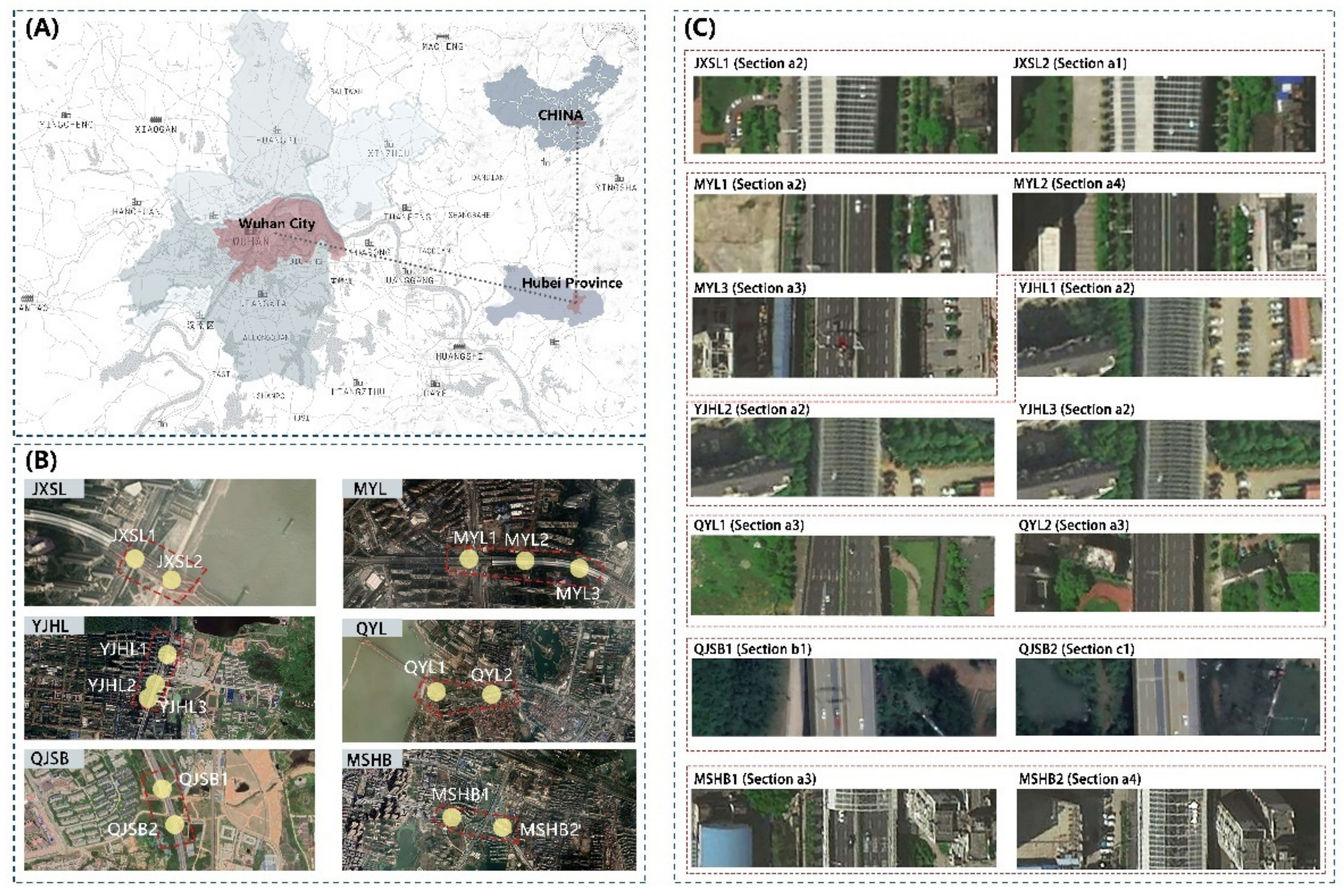
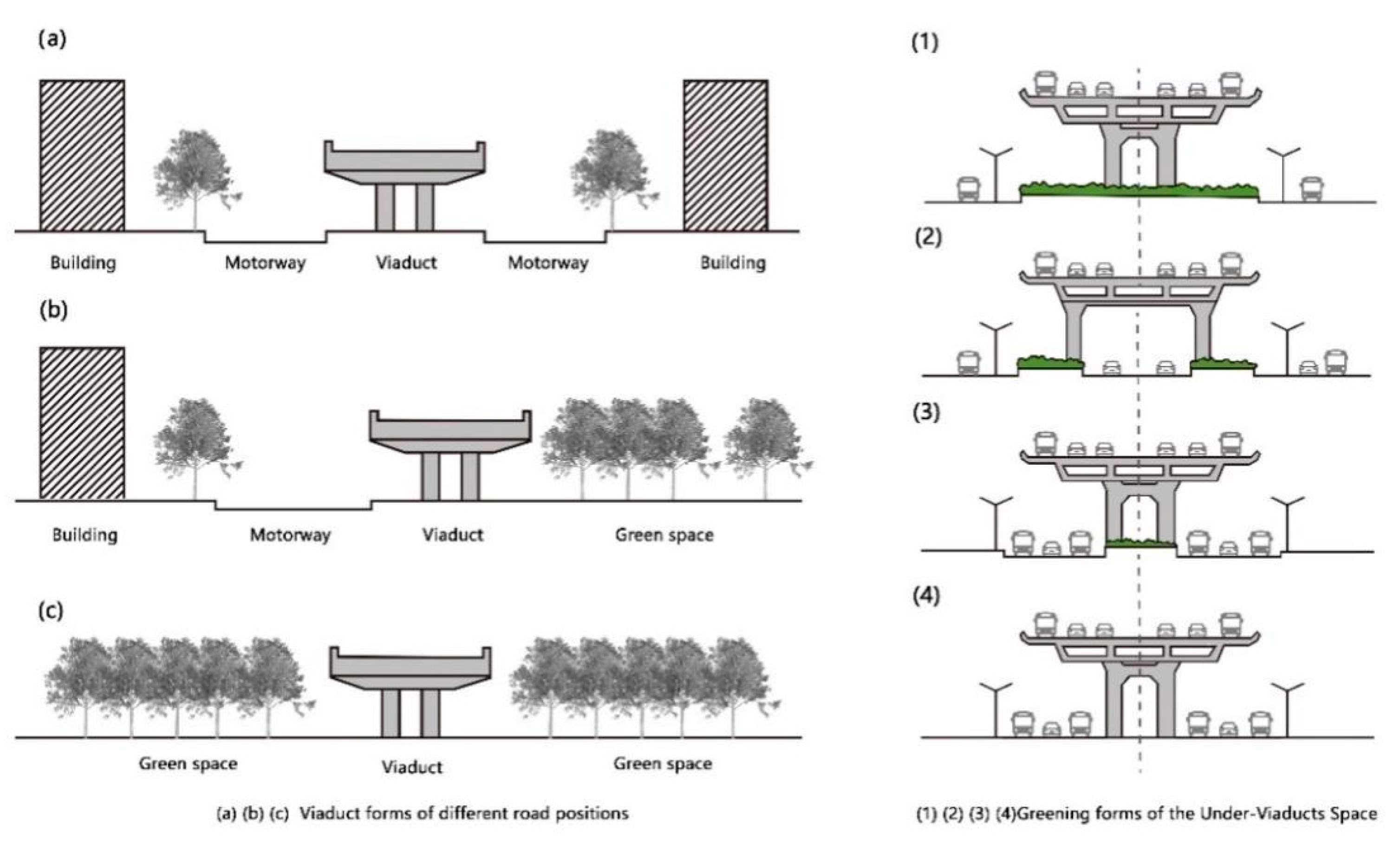

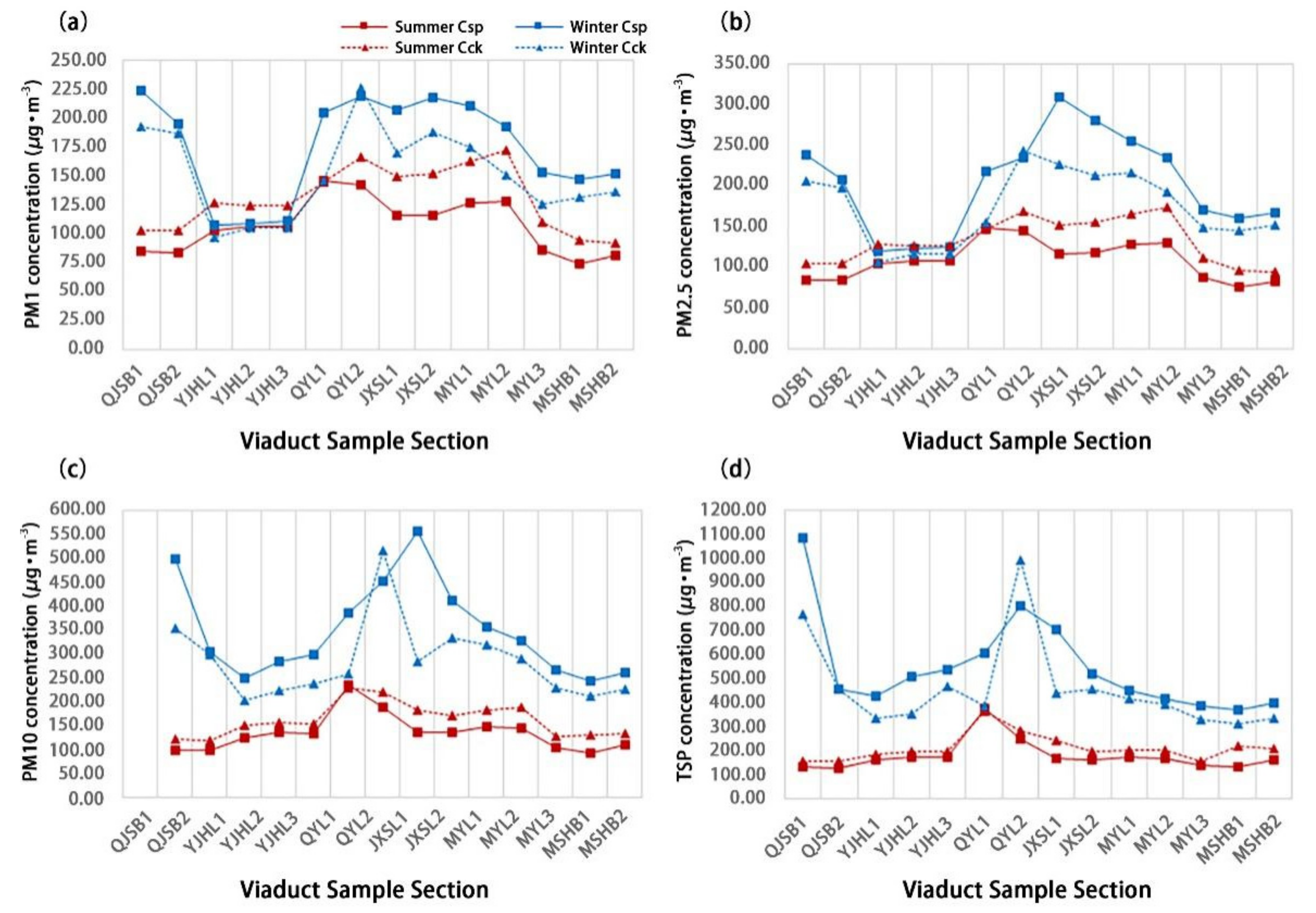
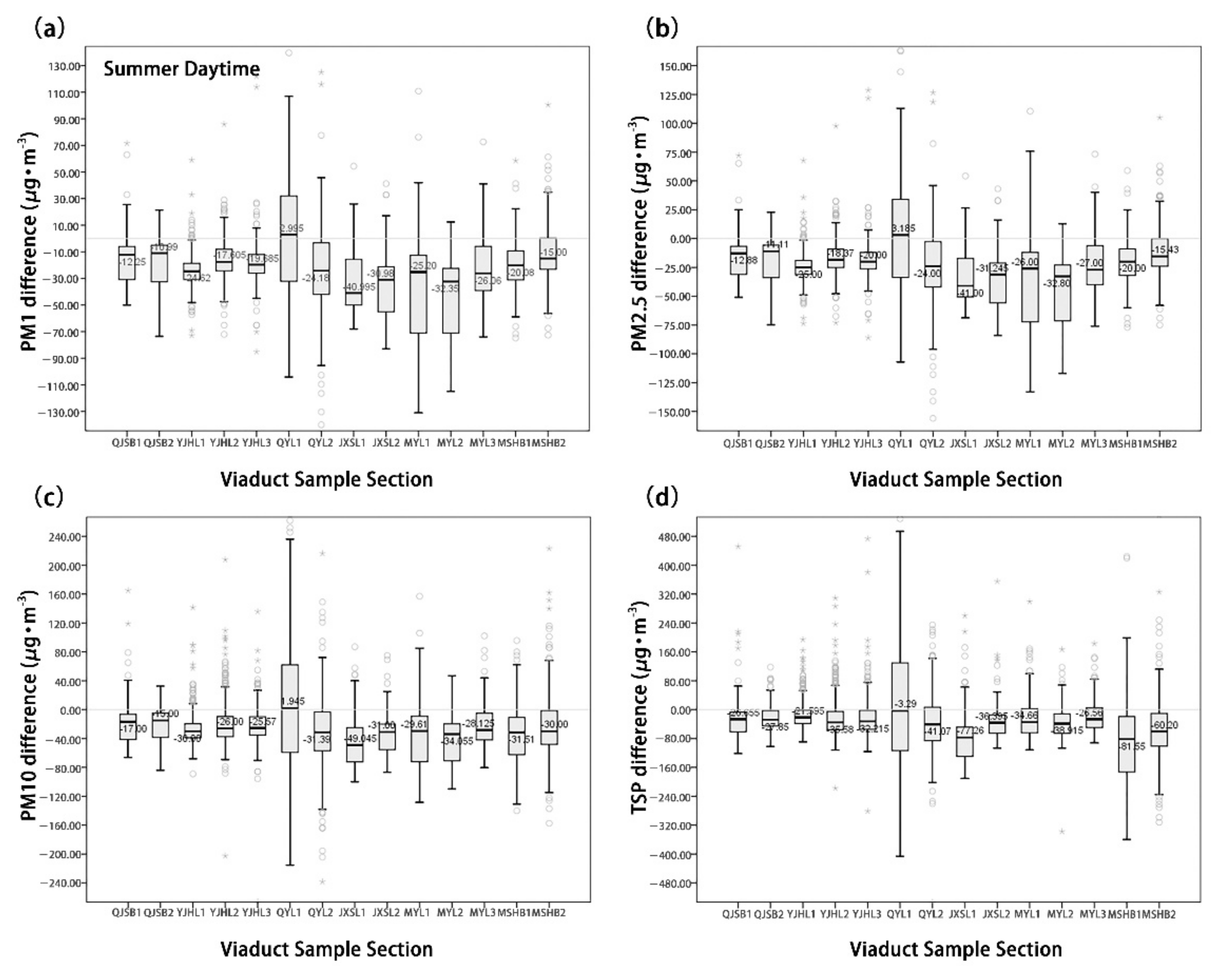
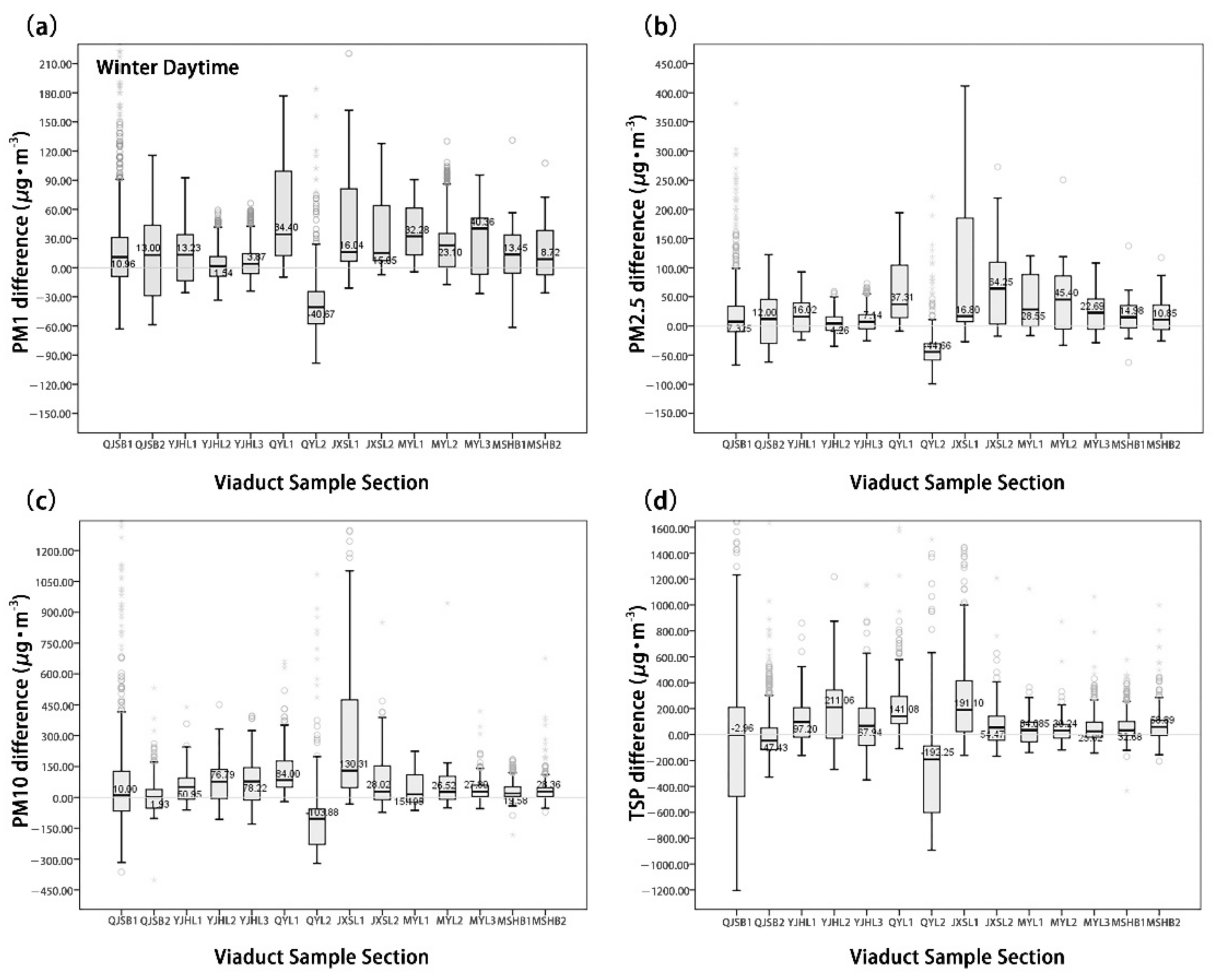
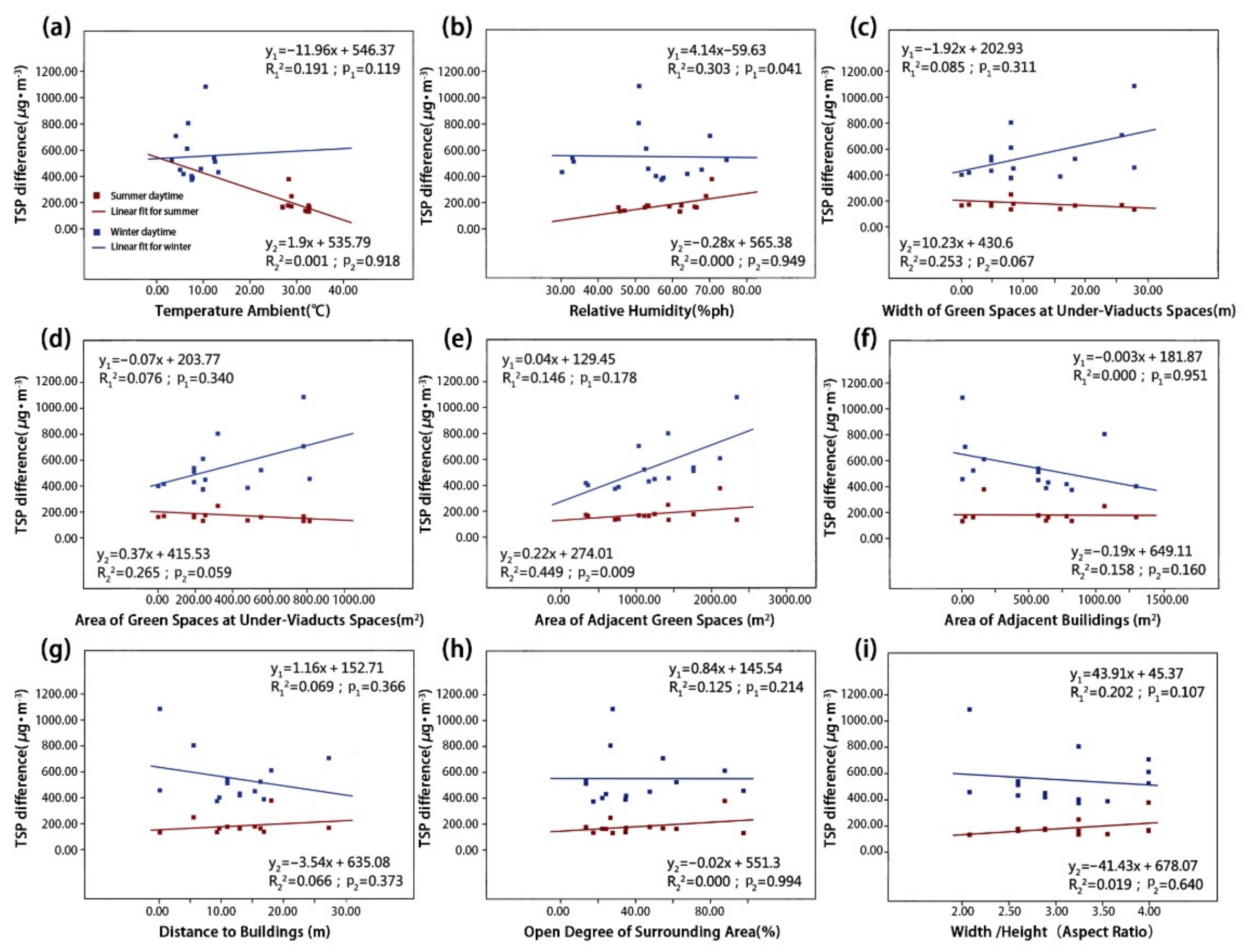
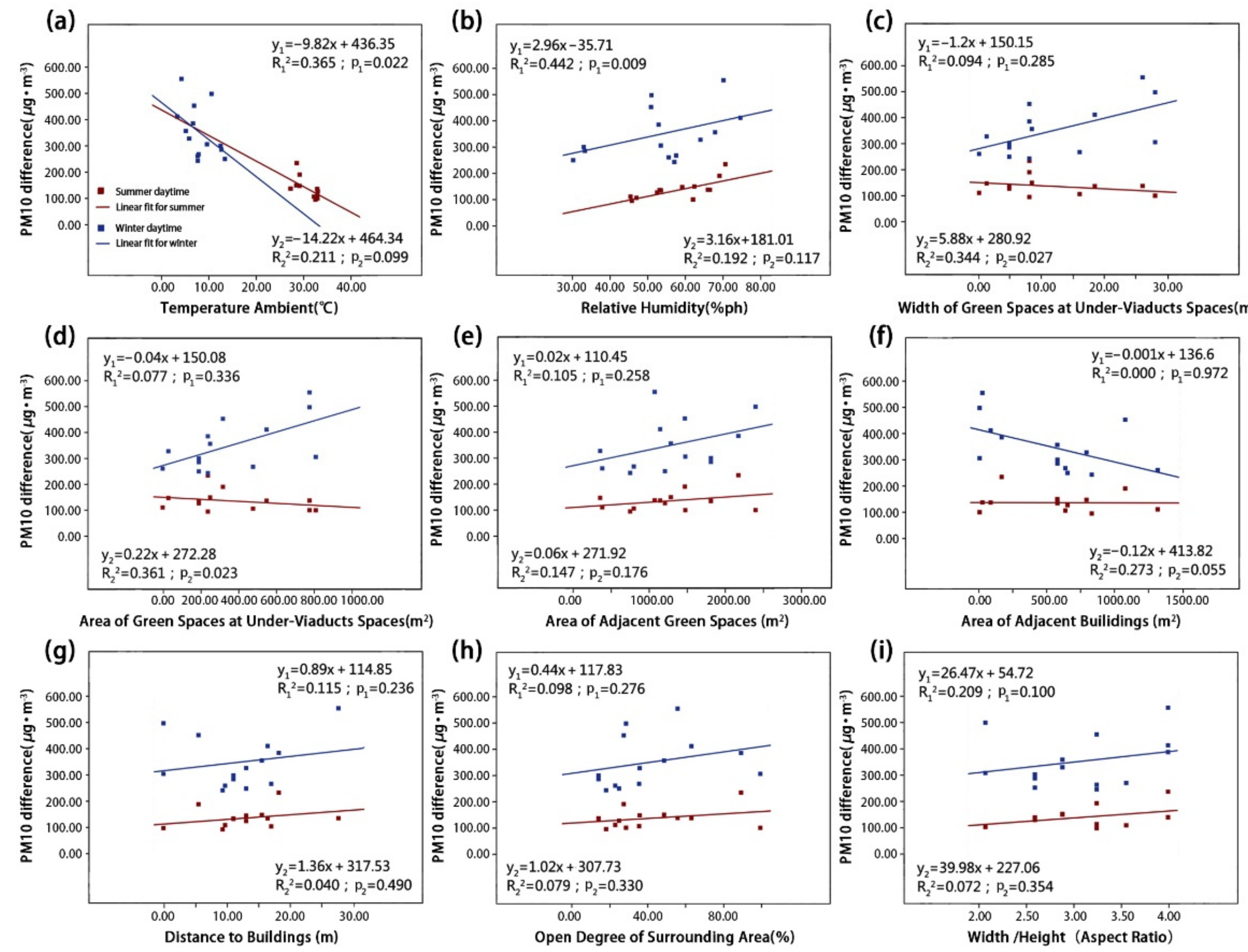
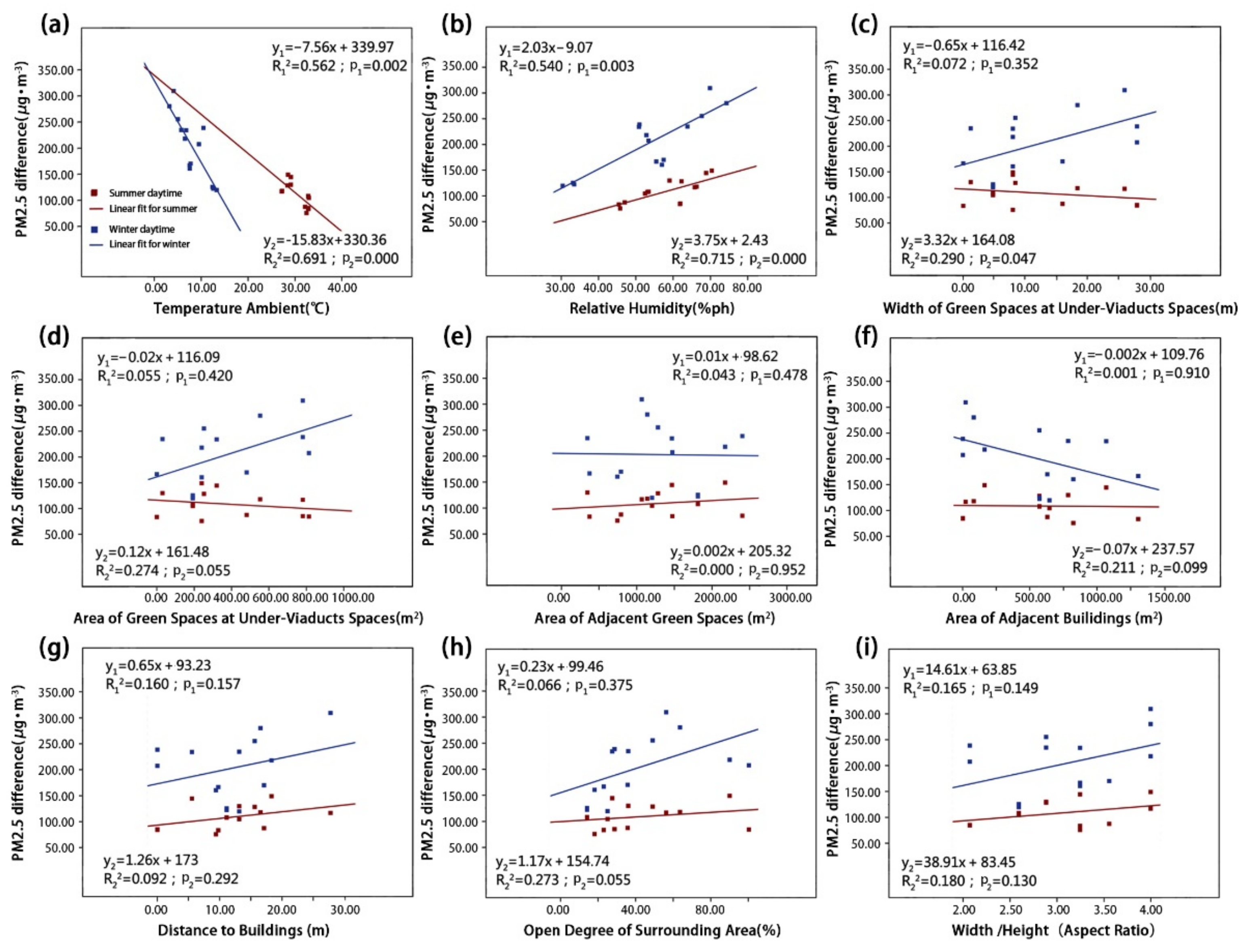
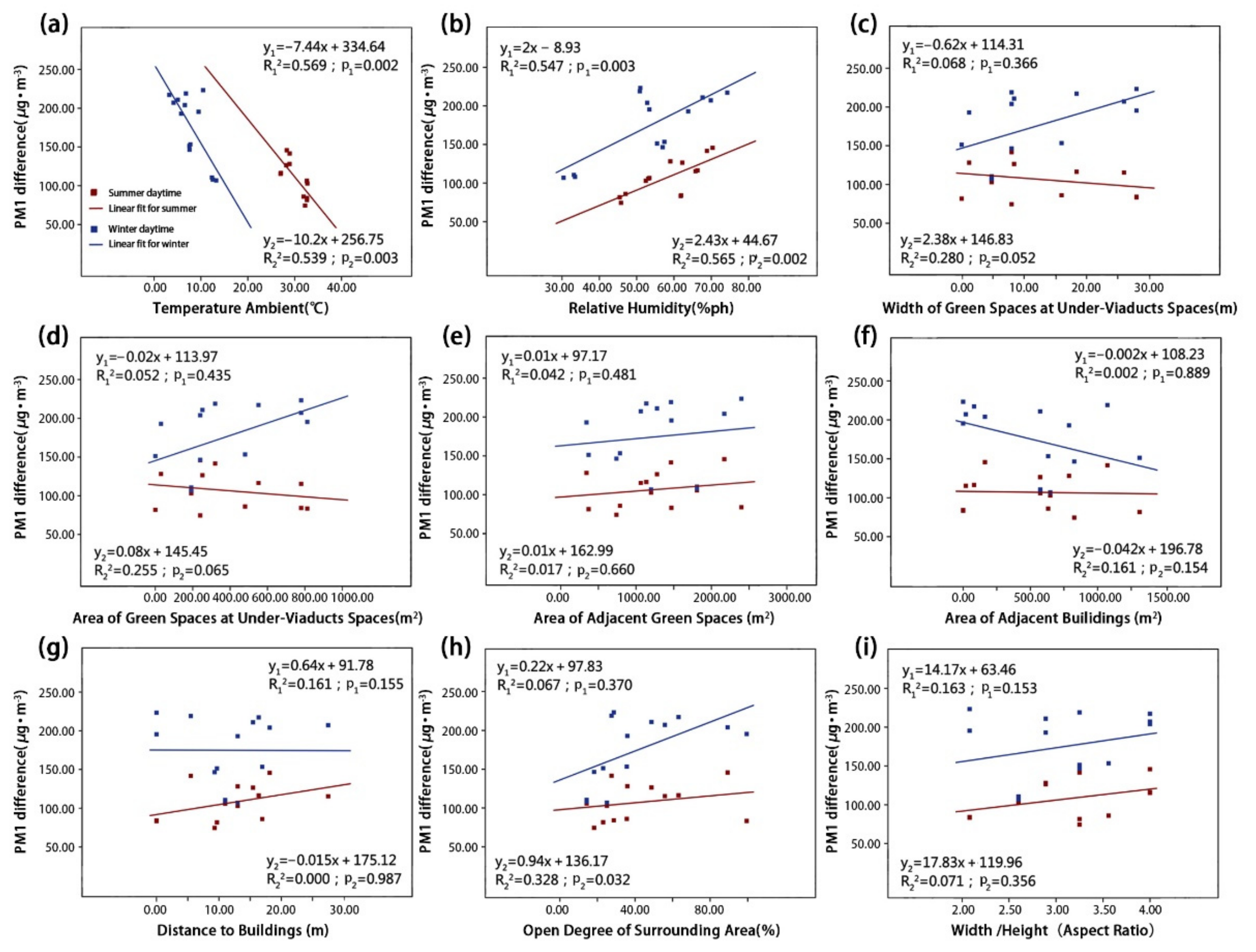
| Viaduct Sample Sections | Ta | RH | UVSgw | UVSga | Aga | Aba | Abd | Aod | B/H | ||
|---|---|---|---|---|---|---|---|---|---|---|---|
| Summer | Winter | Summer | Winter | ||||||||
| (°C) | (°C) | (%ph) | (%ph) | (m) | (m2) | (m2) | (m2) | (m) | (%) | ||
| QJSB1 | 32.64 | 10.46 | 61.81 | 50.88 | 25 | 780 | 2398.48 | 0.00 | 0 | 28.72 | 2.08 |
| QJSB2 | 32.59 | 9.50 | 61.73 | 53.31 | 26 | 813 | 1468.83 | 0.00 | 0 | 99.48 | 2.08 |
| YJHL1 | 32.71 | 13.25 | 52.37 | 30.32 | 4.8 | 192 | 1199.51 | 647.94 | 26 | 25.06 | 2.6 |
| YJHL2 | 32.58 | 12.53 | 53.02 | 33.39 | 4.8 | 192 | 1807.98 | 573.66 | 22 | 14.23 | 2.6 |
| YJHL3 | 32.60 | 12.35 | 53.32 | 33.08 | 4.8 | 192 | 1807.98 | 573.66 | 22 | 14.23 | 2.6 |
| QYL1 | 28.31 | 6.57 | 70.26 | 52.74 | 8 | 240 | 2171.00 | 162.13 | 36.25 | 89.34 | 3.56 |
| QYL2 | 28.92 | 6.80 | 68.73 | 50.75 | 8 | 320 | 1463.02 | 1073.27 | 11 | 27.52 | 2.89 |
| JXSL1 | 26.99 | 4.16 | 65.68 | 69.77 | 26 | 780 | 1063.49 | 0 | 55 | 55.90 | 4 |
| JXSL2 | 27.04 | 3.26 | 66.19 | 74.19 | 18.4 | 552 | 1136.72 | 81.25 | 32.74 | 63.18 | 4 |
| MYL1 | 28.20 | 5.06 | 62.13 | 67.57 | 8.4 | 252 | 1278.00 | 572.80 | 30.91 | 48.77 | 2.6 |
| MYL2 | 28.90 | 5.78 | 58.93 | 63.72 | 1.2 | 30 | 342.00 | 787.71 | 26 | 35.93 | 2.6 |
| MYL3 | 31.91 | 7.73 | 46.94 | 57.34 | 16 | 480 | 786.79 | 632.27 | 33.88 | 35.63 | 3.2 |
| MSHB1 | 32.22 | 7.57 | 45.71 | 56.88 | 8 | 240 | 739.52 | 826.53 | 18.6 | 18.22 | 2.89 |
| MSHB2 | 32.62 | 7.53 | 45.36 | 55.38 | 0 | 0 | 370.00 | 1312.86 | 19.36 | 23.05 | 2.89 |
| dPM1.0 | dPM2.5 | dPM10 | dTSP | |||||
|---|---|---|---|---|---|---|---|---|
| R12 | R22 | R12 | R22 | R12 | R22 | R12 | R22 | |
| Ta | 0.569 | 0.539 | 0.562 | 0.691 | 0.365 | 0.211 | 0.191 | 0.001 |
| RH | 0.509 | 0.565 | 0.540 | 0.715 | 0.442 | 0.192 | 0.303 | 0.000 |
| UVSgw | 0.068 | 0.280 | 0.072 | 0.290 | 0.094 | 0.344 | 0.085 | 0.253 |
| UVSga | 0.052 | 0.255 | 0.055 | 0.274 | 0.077 | 0.361 | 0.076 | 0.265 |
| Aga | 0.042 | 0.017 | 0.043 | 0.000 | 0.105 | 0.147 | 0.146 | 0.449 |
| Aba | 0.002 | 0.161 | 0.001 | 0.211 | 0.000 | 0.273 | 0.000 | 0.158 |
| Abd | 0.161 | 0.000 | 0.160 | 0.092 | 0.115 | 0.040 | 0.069 | 0.066 |
| Aod | 0.067 | 0.328 | 0.066 | 0.273 | 0.098 | 0.079 | 0.125 | 0.000 |
| B/H | 0.163 | 0.071 | 0.165 | 0.180 | 0.209 | 0.072 | 0.202 | 0.019 |
| Variables | Summer dPM1.0 | Summer dPM2.5 | Summer dPM10 | Summer dTSP | ||||||||
|---|---|---|---|---|---|---|---|---|---|---|---|---|
| Coefficient | Sig. c | Coefficient | Sig. c | Coefficient | Sig. c | Coefficient | Sig. c | |||||
| B a | Beta b | B a | Beta b | B a | Beta b | B a | Beta b | |||||
| Ta | 33.256 | 1.214 | 0.001 | |||||||||
| RH | 2.590 | 0.958 | 0.000 | 2.644 | 0.957 | 0.000 | 2.788 | 0.626 | 0.001 | 11.453 | 1.525 | 0.000 |
| UVSgw | −1.463 | −0.619 | 0.000 | −1.513 | −0.626 | 0.000 | ||||||
| UVSga | −0.055 | −0.393 | 0.027 | −0.166 | −0.709 | 0.000 | ||||||
| Aga | 0.035 | 0.566 | 0.003 | |||||||||
| Aba | 0.058 | 0.630 | 0.015 | |||||||||
| Abd | 0.353 | 0.221 | 0.007 | 0.358 | 0.219 | 0.007 | 1.098 | 0.417 | 0.004 | |||
| Aod | 0.523 | 0.370 | 0.021 | |||||||||
| B/H | 87.910 | 0.900 | 0.000 | |||||||||
| Constant | −34.467 | −35.385 | −128.353 | −1711.484 | ||||||||
| R2 | 0.959 | 0.959 | 0.960 | 0.910 | ||||||||
| Adjusted R2 | 0.947 | 0.947 | 0.925 | 0.870 | ||||||||
| Variables | Winter dPM1.0 | Winter dPM2.5 | Winter dPM10 | Winter dTSP | ||||||||
|---|---|---|---|---|---|---|---|---|---|---|---|---|
| Coefficient | Sig. c | Coefficient | Sig. c | Coefficient | Sig. c | Coefficient | Sig. c | |||||
| B a | Beta b | B a | Beta b | B a | Beta b | B a | Beta b | |||||
| Ta | −53.590 | −3.859 | 0.000 | −67.602 | −3.550 | 0.002 | −190.056 | −6.136 | 0.001 | −408.430 | −6.504 | 0.000 |
| RH | −9.374 | −2.899 | 0.001 | −11.031 | −2.488 | 0.009 | −39.637 | −5.496 | 0.001 | −93.070 | −6.365 | 0.000 |
| UVSgw | 19.967 | 4.442 | 0.010 | 21.708 | 3.522 | 0.042 | 77.014 | 7.681 | 0.006 | 213.995 | 10.528 | 0.001 |
| UVSga | −0.585 | −3.648 | 0.019 | −0.585 | −2.661 | 0.077 | −2.127 | −5.945 | 0.013 | −6.212 | −8.563 | 0.001 |
| Aga | ||||||||||||
| Aba | ||||||||||||
| Abd | 1.370 | 0.329 | 0.038 | 3.228 | 0.477 | 0.031 | ||||||
| Aod | −0.480 | −0.215 | 0.098 | −2.524 | −0.695 | 0.004 | −6.816 | −0.925 | 0.000 | |||
| B/H | −54.632 | −0.818 | 0.001 | −80.255 | −0.876 | 0.004 | −170.174 | −1.142 | 0.005 | −262.021 | −0.867 | 0.003 |
| Constant | 1252.466 | 1527.777 | 4415.145 | 9636.803 | ||||||||
| R2 | 0.944 | 0.969 | 0.941 | 0.928 | ||||||||
| Adjusted R2 | 0.908 | 0.932 | 0.873 | 0.867 | ||||||||
Publisher’s Note: MDPI stays neutral with regard to jurisdictional claims in published maps and institutional affiliations. |
© 2021 by the authors. Licensee MDPI, Basel, Switzerland. This article is an open access article distributed under the terms and conditions of the Creative Commons Attribution (CC BY) license (https://creativecommons.org/licenses/by/4.0/).
Share and Cite
Yin, L.; Hang, T.; Qin, F.; Lin, X.; Han, Y. Measuring and Quantifying Impacts of Environmental Parameters on Airborne Particulate Matter in Under-Viaducts Spaces in Wuhan, China. Int. J. Environ. Res. Public Health 2021, 18, 5197. https://doi.org/10.3390/ijerph18105197
Yin L, Hang T, Qin F, Lin X, Han Y. Measuring and Quantifying Impacts of Environmental Parameters on Airborne Particulate Matter in Under-Viaducts Spaces in Wuhan, China. International Journal of Environmental Research and Public Health. 2021; 18(10):5197. https://doi.org/10.3390/ijerph18105197
Chicago/Turabian StyleYin, Lihua, Tian Hang, Fanfan Qin, Xueting Lin, and Yiwen Han. 2021. "Measuring and Quantifying Impacts of Environmental Parameters on Airborne Particulate Matter in Under-Viaducts Spaces in Wuhan, China" International Journal of Environmental Research and Public Health 18, no. 10: 5197. https://doi.org/10.3390/ijerph18105197
APA StyleYin, L., Hang, T., Qin, F., Lin, X., & Han, Y. (2021). Measuring and Quantifying Impacts of Environmental Parameters on Airborne Particulate Matter in Under-Viaducts Spaces in Wuhan, China. International Journal of Environmental Research and Public Health, 18(10), 5197. https://doi.org/10.3390/ijerph18105197






